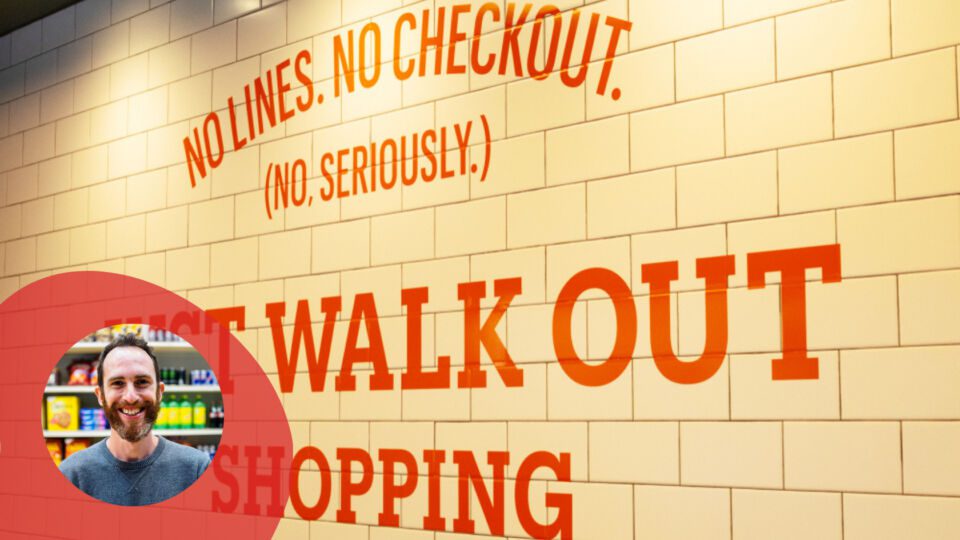Autonomous checkout (sometimes called cashierless checkout) is the biggest change in retail since the advent of ecommerce, and it’s on the radar of just about every retailer. While some of that interest was prompted by COVID-19 and the need to reduce as many physical touch points as possible, retailers want autonomous checkout for several other reasons: primarily to create better and unique experiences for customers, but also to collect better data on shopping and to streamline store operations such as inventory and restocking. Most are not looking to eliminate jobs; they will likely move cashier positions to the store floor to assist customers.
Amazon Go, while not the first in the space, is the most well-known. Its stores famously allow people to Just Walk Out — after logging into an app and going through a turnstile to enter a store. The stores themselves are outfitted with hundreds of shelf sensors and cameras. It’s an approach that works for Amazon, because they are able to build their stores around the technology.
But what about retailers that already have existing stores?
It’s a fair question to ask, because the market for autonomous checkout in existing stores is exponentially larger than the market for new stores. It’s highly unlikely that more than a handful of retailers will scrap existing stores and build brand new ones in order to get autonomous checkout.
It’s also not necessary, because there are other options. It’s now possible for retailers to implement autonomous checkout technology that works in any existing store and allows customers to walk in, grab what they need, and walk out without waiting in line or stopping to scan or pay. There are systems that rely primarily on cameras equipped with computer vision software, rather than shelf sensors, to automatically detect which items a person picks up and leaves the store with. These are called camera-first systems.
The three major benefits of this approach are:
Faster and easier deployment: Installing cameras on the ceiling and a server in a back room is relatively easy and can usually be completed in a few days. Much of the work can be done overnight so stores don’t even have to close. Compare this to the Amazon Go model of removing everything in the store down to bare walls and floors and starting from scratch — a process that can take months and requires long-term store closures.
Flexibility to accommodate any store layout and operation: A camera-first approach comes with a much smaller footprint and can accommodate virtually any retail layout. It also works with a retailer’s current product assortment, fixtures and lighting as well as its existing inventory management and replenishment processes. The one store-layout change most retailers choose to make is eliminating traditional cashier stations and the lines that come with them. This in turn frees up previously unavailable premium store space for more merchandising, and provides customers with a frictionless shopping experience where they don’t have to stop to scan or pay.
Much lower cost: Total cost of ownership for these camera-first solutions is low compared to hardware-intensive approaches such as Amazon Go’s. Implementation is relatively simple — mostly ceiling-mounted cameras — and most maintenance can be handled remotely. So not only are the hardware costs much lower, but so are implementation and maintenance costs. The difference can be 10X.
Self-checkout was an early attempt at autonomous checkout; however, these systems have fallen out of favor around the world as many customers avoid them, and they tend to increase shrinkage. The second generation was technology like Amazon Go — stores built around technology. The third generation is camera-first technology that can be implemented in existing stores. It represents a giant leap forward for retailers that want autonomous checkout but don’t want to have to build new stores in order to get it.
In focusing on a solution that can be installed in existing stores and works with existing store technology, vendors are solving a much harder problem than Amazon. But it’s been done, using computer vision and AI technology.
The world’s first retrofitted autonomous stores opened in 2020. These implementations demonstrate to all retailers that autonomous checkout can be implemented in existing stores. We are already working with retailers like Circle K and the Compass Group to outfit hundreds of checkout-free stores in 2021 and beyond, with a goal of more than 50,000 stores in the next five years.
As the COVID-19 pandemic winds down, in-store shopping is forever changed. Shoppers will be looking for contactless experiences, and they don’t want to wait in line. Drawing customers back in from online options requires brick-and-mortar retailers to provide better customer experiences. Autonomous checkout is one of them.
Jordan Fisher is CEO and Co-founder of Standard, a startup bringing fully autonomous checkout to physical retail. Fisher has spent his career focusing on both fundamental research and product development. He has worked in computational fluid dynamics, securities regulations, video games, machine learning and retail, and seeks out areas where innovative products can be forged by tackling difficult research initiatives.




